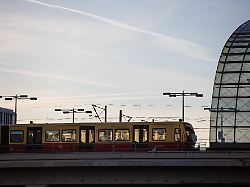One city in particular stands out
S-Bahn trains are becoming increasingly unpunctual
February 12, 2024, 7:55 a.m
Listen to article
This audio version was artificially generated. More info | Send feedback
Deutsche Bahn is not exactly known for its punctuality. This is also evident in S-Bahn traffic. Here, a train that is almost six minutes late is still considered to be on time. Nevertheless, the company is increasingly failing to meet even this generous standard in many regions.
The S-Bahn trains operated by Deutsche Bahn were less punctual last year than in previous years. This emerges from a response from the Federal Ministry of Transport to a request from Green MP Matthias Gastel. According to this, 92.5 percent of the stops on these S-Bahn trains were reached on time last year. In 2019 the punctuality rate was 95.3 percent, in 2020 it was 96.5 percent.
The nine largest S-Bahn networks operated by Deutsche Bahn were compared. A train is considered to be on time in these statistics if it reaches a stop with a maximum delay of 5:59 minutes. However, in rush hour traffic with overall short travel times, it can often lead to missing the connection.
According to statistics, the S-Bahn Rhine-Ruhr (85.2 percent) and Rhine-Neckar (86.3 percent) were particularly unpunctual. The S-Bahn Berlin (96.6 percent) and Hamburg (96.5 percent) recorded the best values. Also listed were the S-Bahn in Munich (89.5 percent), Rhine-Main (88.4 percent), Cologne (87.9 percent), Stuttgart (89.1 percent) and Central Germany (95.6 percent). With the exception of the Rhine-Neckar S-Bahn, punctuality on all trains worsened compared to the previous year. The rate fell particularly significantly in Stuttgart – by four percentage points.
“The S-Bahn trains are increasingly running behind their own timetables. The causes often have to do with disruptions to the infrastructure and insufficient capacity in overloaded rail nodes,” said Gastel. “What is needed is greater long-term investment in a more efficient and less fault-prone infrastructure.” Because the railway will likely have less money available in the coming years following the federal budget chaos, some planned infrastructure projects are unlikely to come to fruition for the time being.
